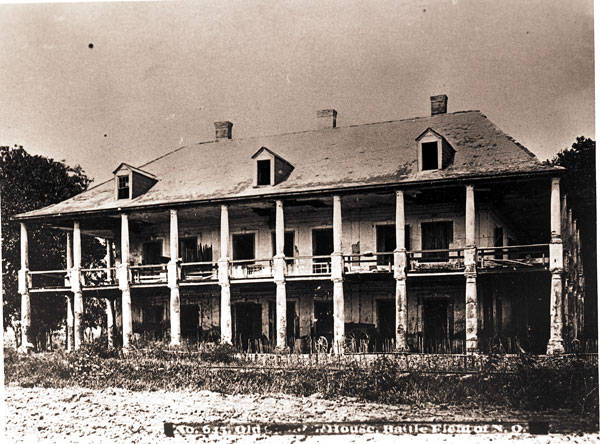They are somewhat in chronological order by date taken. Hope you enjoy these as much as I did:

2020 Louisiana Teacher of the Year & National Teacher of the Year Finalist
A fascinating yet painful look at some of New Orleans’ iconic landmarks that did not endure the test of time. As Benny Grunch would say, they just “ain’t dere no more.”
1. First Saint Charles Hotel

The first Saint Charles Hotel was built in 1835. A traveling Brit called it the “finest piece of architecture in the New World.” It met its fate in an 1851 fire that burned many other historic structures to the ground as well. This 1847 photo is one of the only known surviving photos of the structure.
“A blow across the shins with a racket is permissible, and broken heads are not uncommon.”
The Choctaw Nation of the lower Mississippi River Valley was one of the most influential yet lesser-known groups of 18th century New Orleans. Since French involvement in the region, interactions between the groups were frequent. Native-American and African-American relations were also common considering French and subsequent Spanish law was more lenient than English law.
Background
Despite common belief, the American Revolution was more than 13 colonies fighting an oppressive European force; it was a transatlantic conflict involving multiple countries and their colonies. Louisiana, then under the Spanish flag, waged impressive campaigns to attack British territories and undermine the British war effort.
Spain decided to assist the rebels because of their humiliating loss to Great Britain during the French and Indian War, which was the North American theater of the Seven Years War. In 1762, Spain offered to help France in exchange for all of the Louisiana territory west of the Mississippi River, including the city of New Orleans. However, Spain surrendered East and West Florida to Great Britain.
Continue reading “Louisiana’s Fight in the Revolutionary War”
The Civil War broke out in 1861. The Union captured New Orleans in April, 1862, saving the city from the destruction faced by other Southern cities. New Orleans remained an occupied city until the end of the war.
Continue reading “White-Passing Enslaved Kids of New Orleans (PHOTOS)”
The word levee comes from the French verb lever, “to raise”, and was first used in New Orleans shortly after its foundation. As humanity’s battle with water continues, millions depend on them. Nowhere is this truer than the New Orleans region, where battling nature is second nature. Unfortunately, Louisiana levees in 1927 faced an atypical enemy; humanity.
Continue reading “When the Levees Blew Up: A “Public Execution” of a Community”
After the United States took control of New Orleans via the Louisiana Purchase in 1803, thousands of Americans migrated there to seek better opportunities. Many of them moved into the emerging American sector of New Orleans as they did not mesh well with the already existing Creoles. The Creoles looked at them as barbaric, but noticed that those from Kentucky were the most boisterous. Creoles nicknamed them “Kaintock”, and the term eventually referred to all incoming Americans. The resentment was mutual. The Americans looked at the Creoles as snobbish and unwelcoming, and nicknamed them “crapaud”, meaning frog in French. The bitter contrast between the two led to an agreement to build a canal on a major thoroughfare dividing them. The canal was never built, but the street remained as Canal Street. The median in the middle was dubbed the “neutral ground”, and to this day the medians in the New Orleans area are called “neutral grounds”.
The American Gilded Age provided economic opportunities and living wages substantially higher than Europe. The rise of industrialization meant a demand for cheap labor. New Orleans, by far the most populated southern city, was ripe with economic opportunities from hungry factories and emptying plantations. Since busy trade routes already existed from Sicily to New Orleans, Italian migration was convenient. Italians poured into the city. Increase in labor competition outraged impoverished whites and the increase in Catholicization in an already Catholic dominated city incensed white Protestants, who had been migrating into New Orleans since the Louisiana Purchase. Italians were also known for their labor organization, inevitably upsetting those who control the means of production. Italophobia was rampant in 19th century New Orleans.
Continue reading “Vendetta: A Mass Lynching of Italians in New Orleans”
Race violence was all too common throughout American history. As I studied the history of my own parish, St. Bernard, I started to unravel a brutal massacre absent from almost any historical narrative. Congressional inquiries into the massacre paint an atrocity. At the time it was dubbed the St. Bernard Riot, but it really has no official name. What’s in a name, anyway? The term riot was provided by whites, whether in the newspapers or remaining government records. That term does not give it justice, and implies mass chaos must’ve ensued. It has been recognized and used by the very few who mention it, but I choose to label it by a much more appropriate term: The St. Bernard Massacre of 1868. It was not chaotic, but a deliberate, systematic slaughter of humans who were just liberated from their chains circa six years prior à la the Emancipation Proclamation. In order to understand the violence, we must understand the circumstances associated with it.
Continue reading “A Forgotten Massacre in Southeast Louisiana”